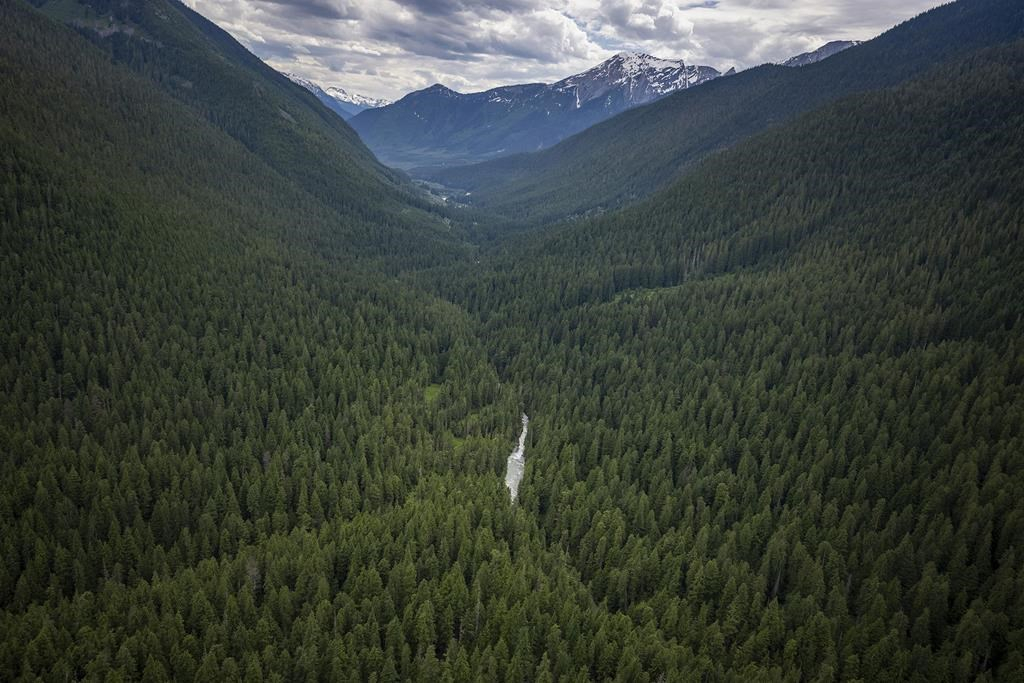A valley of giant trees, lakes and wetlands in southeastern British Columbia nearly 200 times the size of Vancouver’s Stanley Park is being preserved in an agreement with governments, Indigenous groups, a forest company and the Nature Conservancy of Canada.
The partnership to protect the Incomappleux Valley east of Revelstoke, B.C., involves Interfor Corp. giving up about 75,000 hectares of its forest tenure.
The valley is a rare inland temperate rainforest with substantial areas of mature and old-growth trees, some ranging in age from 800 to 1,500 years.
The forest also supports hundreds of lichen species, some that are new to science. It provides habitat for grizzly and black bears, as well as a variety of endangered fungal and plant species, the government said.
The Nature Conservancy said in a statement that several species at risk are found in the valley, including two endangered bats and the threatened southern mountain caribou.
The northern edge of the project abuts Glacier National Park, which the Nature Conservancy says increases important habitat for wide-ranging animals across the southern Interior B.C. mountains.
The B.C. government said the conservancy covers almost 59,000 hectares, while another 17,000 hectares of forests in the southern part of the valley will be protected from logging.
Environment Minister George Heyman told a group gathered for the announcement on Wednesday at the legislature that the area is one of the few temperate rainforests in the world.
"It is a unique part of the province," he said.
"The conservation community and people who live in the area understood and understand what an important and unique region this is and they've been calling for protection for many years."
Heyman says the announcement supports the B.C. government's commitment to protect 30 per cent of the land base by 2030.
Premier David Eby said the valley is one of B.C.’s greatest treasures, home to old-growth cedars and hemlocks that are four metres in diameter.
“It’s one example of how our province's landscape is a source of beauty, food and recreation and a source of great pride for all British Columbians.”
The environmental group Wildsight said it is celebrating the news.
"The protection comes after decades of threats to the Incomappleux River Valley, including an independent power project, and several attempts to log the remaining ancient forests. In 2005, a landslide occurred in the Incomappleux canyon halting logging operations and making the road impassable."
This report by The Canadian Press was first published Jan. 25, 2023.
yay. one small bit still
yay. one small bit still intact! is it a museum for the future?
I was very happy to hear this
I was very happy to hear this.
Then, perspective set in.
1. What did Interfor receive in return?
2. Using the rounded off number of 75,000ha, calculated against the total area of BC, being just shy of 94.5 MILLION ha, this protected area represents 0.0008% (less than 1/10 of 1%) of BC land area.
3. By comparison, the Stein Valley, near Lytton, protected as a park after a significant protest contemporary with that in Clayoquot Sound (War in the Woods), is 107,000ha.
https://bcparks.ca/explore/parkpgs/stein_val/
I'll let the reader do the math regarding how many of these announcements, combined, add up to 30%. (Hint: something north of 300). Not that 30% ought to be a cap on the size of the protected area of a piece of the planet larger than France and Germany combined.
Unfortunately, the Wilderness Committee didn't include references in the following, so I invite referenced rebuttal.
"In BC, 64 per cent of reptiles and turtles, 58 per cent of ferns, 46 per cent of (dicot) plants and 45 per cent of amphibians are currently at risk.
"About half of the total grizzly bear population in Canada lives in BC, as do more bird species than any other province, with over 500 bird species including more than 300 breeding species."




Comments